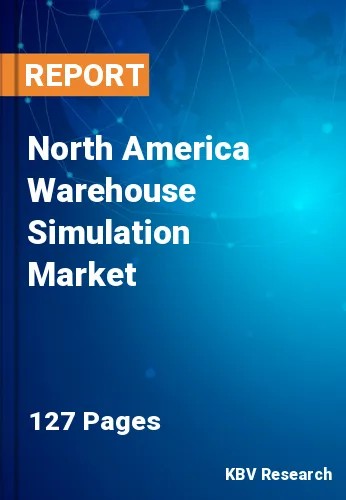Chapter 1. Market Scope & Methodology
1.1 Market Definition
1.2 Objectives
1.3 Market Scope
1.4 Segmentation
1.4.1 North America Warehouse Simulation Market, by Deployment
1.4.2 North America Warehouse Simulation Market, by Vertical
1.4.3 North America Warehouse Simulation Market, by Type
1.4.4 North America Warehouse Simulation Market, by Country
1.5 Methodology for the research
Chapter 2. Market at a Glance
2.1 Key Highlights
Chapter 3. Market Overview
3.1 Introduction
3.1.1 Overview
3.1.1.1 Market Composition and Scenario
3.2 Key Factors Impacting the Market
3.2.1 Market Drivers
3.2.2 Market Restraints
3.2.3 Market Opportunities
3.2.4 Market Challenges
Chapter 4. Competition Analysis - Global
4.1 KBV Cardinal Matrix
4.2 Recent Industry Wide Strategic Developments
4.2.1 Partnerships, Collaborations and Agreements
4.2.2 Product Launches and Product Expansions
4.2.3 Acquisition and Mergers
4.3 Market Share Analysis, 2023
4.4 Top Winning Strategies
4.4.1 Key Leading Strategies: Percentage Distribution (2020-2024)
4.4.2 Key Strategic Move: (Product Launches and Product Expansions: 2021, Sep – 2024, May) Leading Players
4.5 Porter Five Forces Analysis
Chapter 5. North America Warehouse Simulation Market by Deployment
5.1 North America On-Premises Market by Region
5.2 North America Cloud-Based Market by Region
Chapter 6. North America Warehouse Simulation Market by Vertical
6.1 North America Automotive Market by Country
6.2 North America Consumer Electronics Market by Country
6.3 North America Healthcare & Pharmaceuticals Market by Country
6.4 North America Food & Beverage Market by Country
6.5 North America Retail & E-commerce Market by Country
6.6 North America Logistics & Transportation Market by Country
6.7 North America Other Vertical Market by Country
Chapter 7. North America Warehouse Simulation Market by Type
7.1 North America Discrete Event Simulation (DES) Market by Country
7.2 North America Agent-Based Simulation (ABS) Market by Country
7.3 North America System Dynamics Simulation Market by Country
7.4 North America Hybrid Simulation Market by Country
Chapter 8. North America Warehouse Simulation Market by Country
8.1 US Warehouse Simulation Market
8.1.1 US Warehouse Simulation Market by Deployment
8.1.2 US Warehouse Simulation Market by Vertical
8.1.3 US Warehouse Simulation Market by Type
8.2 Canada Warehouse Simulation Market
8.2.1 Canada Warehouse Simulation Market by Deployment
8.2.2 Canada Warehouse Simulation Market by Vertical
8.2.3 Canada Warehouse Simulation Market by Type
8.3 Mexico Warehouse Simulation Market
8.3.1 Mexico Warehouse Simulation Market by Deployment
8.3.2 Mexico Warehouse Simulation Market by Vertical
8.3.3 Mexico Warehouse Simulation Market by Type
8.4 Rest of North America Warehouse Simulation Market
8.4.1 Rest of North America Warehouse Simulation Market by Deployment
8.4.2 Rest of North America Warehouse Simulation Market by Vertical
8.4.3 Rest of North America Warehouse Simulation Market by Type
Chapter 9. Company Profiles
9.1 Simio LLC
9.1.1 Company Overview
9.1.2 Recent strategies and developments:
9.1.2.1 Product Launches and Product Expansions:
9.1.3 SWOT Analysis
9.2 AnyLogic North America, LLC (The AnyLogic Company)
9.2.1 Company Overview
9.2.2 Recent strategies and developments:
9.2.2.1 Product Launches and Product Expansions:
9.2.3 SWOT Analysis
9.3 Rockwell Automation, Inc.
9.3.1 Company Overview
9.3.2 Financial Analysis
9.3.3 Segmental and Regional Analysis
9.3.4 Research & Development Expenses
9.3.5 Recent strategies and developments:
9.3.5.1 Partnerships, Collaborations, and Agreements:
9.3.5.2 Product Launches and Product Expansions:
9.3.5.3 Acquisition and Mergers:
9.3.6 SWOT Analysis
9.4 Siemens AG
9.4.1 Company Overview
9.4.2 Financial Analysis
9.4.3 Segmental and Regional Analysis
9.4.4 Research & Development Expense
9.4.5 Recent strategies and developments:
9.4.5.1 Partnerships, Collaborations, and Agreements:
9.4.5.2 Product Launches and Product Expansions:
9.4.5.3 Acquisition and Mergers:
9.4.6 SWOT Analysis
9.5 Dassault Systemes SE
9.5.1 Company Overview
9.5.2 Financial Analysis
9.5.3 Regional Analysis
9.5.4 Research & Development Expense
9.5.5 Recent strategies and developments:
9.5.5.1 Partnerships, Collaborations, and Agreements:
9.5.6 SWOT Analysis
9.6 Autodesk, Inc.
9.6.1 Company Overview
9.6.2 Financial Analysis
9.6.3 Regional Analysis
9.6.4 Research & Development Expenses
9.6.5 Recent strategies and developments:
9.6.5.1 Acquisition and Mergers:
9.6.6 SWOT Analysis
9.7 Manhattan Associates, Inc.
9.7.1 Company Overview
9.7.2 Financial Analysis
9.7.3 Segmental and Regional Analysis
9.7.4 Research & Development Expenses
9.7.5 Recent strategies and developments:
9.7.5.1 Partnerships, Collaborations, and Agreements:
9.7.5.2 Product Launches and Product Expansions:
9.8 Honeywell International, Inc.
9.8.1 Company Overview
9.8.2 Financial Analysis
9.8.3 Segmental and Regional Analysis
9.8.4 Research & Development Expenses
9.8.5 Recent strategies and developments:
9.8.5.1 Product Launches and Product Expansions:
9.8.6 SWOT Analysis
9.9 SAP SE
9.9.1 Company Overview
9.9.2 Financial Analysis
9.9.3 Regional Analysis
9.9.4 Research & Development Expense
9.9.5 Recent strategies and developments:
9.9.5.1 Acquisition and Mergers:
9.9.6 SWOT Analysis
9.10. Oracle Corporation
9.10.1 Company Overview
9.10.2 Financial Analysis
9.10.3 Segmental and Regional Analysis
9.10.4 Research & Development Expense
9.10.5 Recent strategies and developments:
9.10.5.1 Partnerships, Collaborations, and Agreements:
9.10.6 SWOT Analysis

